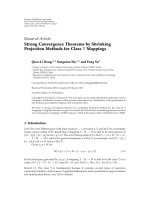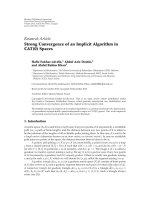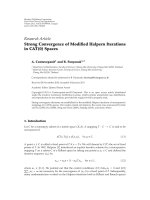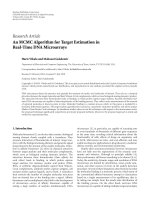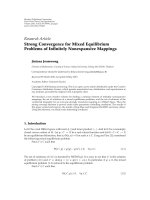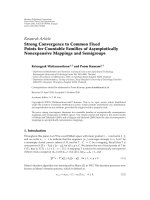Báo cáo hóa học: " WEAK AND STRONG CONVERGENCE THEOREMS FOR NONEXPANSIVE SEMIGROUPS IN BANACH SPACES SACHIKO ATSUSHIBA AND WATARU TAKAHASHI " doc
Bạn đang xem bản rút gọn của tài liệu. Xem và tải ngay bản đầy đủ của tài liệu tại đây (534.65 KB, 12 trang )
WEAK AND STRONG CONVERGENCE THEOREMS FOR
NONEXPANSIVE SEMIGROUPS IN BANACH SPACES
SACHIKO ATSUSHIBA AND WATARU TAKAHASHI
Received 24 February 2005
We introduce an implicit iterative process for a nonexpansive semigroup and then we
prove a weak convergence theorem for the nonexpansive semigroup in a uniformly con-
vex Banach space which satisfies Opial’s condition. Further, we discuss the strong conver-
gence of the implicit iterative process.
1. Introduction
Let C be a closed convex subset of a Hilbert space and let T be a nonexpansive mapping
from C into itself. For each t ∈ (0,1), the contraction mapping T
t
of C into itself defined
by
T
t
x = tu+(1− t)Tx (1.1)
for every x ∈ C, has a unique fixed point x
t
,whereu is an element of C.Browder[4]
proved that {x
t
} converges strongly to a fixed point of T as t → 0inaHilbertspace.Moti-
vated by Browder’s theorem [4], Takahahi and Ueda [20] proved the strong convergence
of the following iterative process in a uniformly convex Banach space with a uniformly
G
ˆ
ateaux differentiable norm (see also [14]):
x
k
=
1
k
x +
1 −
1
k
Tx
k
(1.2)
for every k
= 1,2,3, ,wherex ∈ C. On the other hand, Xu and Ori [21]studiedthe
following implicit iterative process for finite nonexpansive mappings T
1
,T
2
, ,T
r
in a
Hilbert space: x
0
= x ∈ C and
x
n
= α
n
x
n−1
+
1 − α
n
T
n
x
n
(1.3)
for every n = 1,2, ,where{α
n
} is a sequence in (0,1) and T
n
= T
n+r
. And they proved
a weak convergence of the iterative process defined by (1.3) in a Hilbert space. Sun et al.
[17] studied the iterations defined by (1.3) and proved the strong convergence of the
iterations in a uniformly convex Banach space, requiring one mapping T
i
in the family to
be semi compact.
Copyright © 2005 Hindawi Publishing Corporation
Fixed Point Theory and Applications 2005:3 (2005) 343–354
DOI: 10.1155/FPTA.2005.343
344 Weak and strong convergence theorems
In this paper, using the idea of [17, 21], we introduce an implicit iterative process
for a nonexpansive semigroup and then prove a weak convergence theorem for the non-
expansive semigroup in a uniformly convex Banach space which satisfies Opial’s condi-
tion. Further, we discuss the strong convergence of the implicit iterative process (see also
[1, 2, 7, 12, 13]).
2. Preliminaries and notations
Throughout this paper, we denote by N and Z
+
the set of all positive integers and the set
of all nonnegative integers, respectively. Let E be a real Banach space. We denote by B
r
the set {x ∈ E : x≤r}.ABanachspaceE is said to be strictly convex if x + y/2 < 1
for each x, y ∈ B
1
with x = y, and it is said to be uniformly convex if for each ε>0, there
exists δ>0suchthat
x + y/2 ≤ 1 − δ for each x, y ∈ B
1
with x − y≥ε.Itiswell-
known that a uniformly convex Banach space is reflexive and strictly convex (see [19]).
Let C be a closed subset of a Banach space and let T be a mapping from C into itself. We
denote by F(T)andF
ε
(T)forε>0, the sets {x ∈ C : x = Tx} and {x ∈ C : x − Tx≤ε},
respectively .
AmappingT of C into itself is said to be compact if T is continuous and maps bounded
sets into relatively compact sets. A mapping T of C into itself is said to be demicompact
at ξ ∈ C if for any bounded sequence {y
n
} in C such that y
n
− Ty
n
→ ξ as n →∞,there
exists a subsequence {y
n
k
} of {y
n
} and y ∈ C such that y
n
k
→ y as k →∞and y − Ty= ξ.
In particular, a continuous mapping T is demicompact at 0 if for any bounded sequence
{y
n
} in C such that y
n
− Ty
n
→ 0asn →∞, there exists a subsequence {y
n
k
} of {y
n
} and
y ∈ C such that y
n
k
→ y as k →∞. T is also said to be semicompact if T is continuous and
demicompact at 0(e.g.,see[21]). T is said to be demicompact on C if T is demicompact
for each y ∈ C.IfT is compact on C,thenT is demicompact on C. For examples of
demicompact mappings, see [1, 2, 12, 13]. We also denote by I the identity mapping. A
mapping T of C into itself is said to be nonexpansive if Tx − Ty≤x − y for every
x, y ∈ C. We denote by N(C) the set of all nonexpansive mappings from C into itself. We
know from [5]thatifC is a nonempt y closed convex subset of a strictly convex Banach
space, then F(T) is convex for each T ∈ N(C)withF(T) =∅. The following are crucial
to prove our results (see [5, 6]).
Proposition 2.1 (Browder). Let C beanonemptyboundedclosedconvexsubsetofauni-
formly convex Banach space and let T be a nonexpansive mapping from C into itself. Let
{x
n
} be a sequence in C such that it converges weakly to an element x of C and {x
n
− Tx
n
}
converges strong ly to 0. Then x is a fixed point of T.
Proposition 2.2 (Bruck). Let E be a uniformly convex Banach space and let C be a
nonempty closed convex subse t of E.Foranyε>0,thereexistsδ>0 such that for any non-
expansive mapping T of C into itself with F(T)
=∅,
coF
δ
(T) ⊂ F
ε
(T). (2.1)
Let E
∗
be the dual space of a Banach space E.Thevalueofx
∗
∈ E
∗
at x ∈ E will be
denoted by x,x
∗
. We say that a Banach space E satisfies Opial’s condition [11]ifforeach
S. Atsushiba and W. Takahashi 345
sequence {x
n
} in E which converges weakly to x,
lim
n→∞
x
n
− x
< lim
n→∞
x
n
− y
(2.2)
for each y ∈ E with y = x. Since if the duality mapping x →{x
∗
∈ E
∗
: x,x
∗
=x
2
=
x
∗
2
} from E into E
∗
is single-valued and weakly sequentially continuous, then E sat-
isfies Opial’s condition. Each Hilbert space and the sequence spaces
p
with 1 <p<∞
satisfy Opial’s condition (see [8, 11]). Though an L
p
-space with p = 2 does not usually
satisfy Opial’s condition, each separable Banach space can be equivalently renormed so
that it satisfies Opial’s condition (see [11, 22]).
Let S be a semigroup. Let B(S) be the Banach space of all bounded real-valued func-
tions on S with supremum norm. For s ∈ S and f ∈ B(S), we define an element l
s
f in B(S)
by (l
s
f )(t) = f (st)foreacht ∈ S.LetX be a subspace of B(S) containing 1. An element µ
in X
∗
is said to be a mean on X if µ=µ(1) = 1. We often write µ
t
( f (t)) instead of µ( f )
for µ ∈ X
∗
and f ∈ X.LetX be l
s
-invariant, that is, l
s
(X) ⊂ X for each s ∈ S.Ameanµ on
X is said to be left invariant if µ(l
s
f ) = µ( f )foreachs ∈ S and f ∈ X.Asequence{µ
n
}
of means on X is said to be strongly left regular if µ
n
− l
∗
s
µ
n
→0foreachs ∈ S,where
l
∗
s
is the adjoint operator of l
s
. In the case when S is commutative, a strongly left regular
sequence is said to be strongly regular [9, 10]. Let E be a B anach space, let X be a subspace
of B(S) containing 1 and let µ be a mean on X.Letf be a mapping from S into E such
that { f (t):t ∈ S} is contained in a weakly compact convex subset of E and the mapping
t →f (t),x
∗
is in X for each x
∗
∈ E
∗
.Weknowfrom[9, 18] that there exists a unique
element x
0
∈ E such that x
0
,x
∗
=µ
t
f (t), x
∗
for all x
∗
∈ E
∗
. Following [9], we denote
such x
0
by
f (t)dµ(t). Let C be a nonempty closed convex subset of a Banach space E.
A family ={T(t):t ∈ S} is said to be a nonexpansive semigroup on C if it satisfies the
following:
(1) for each t ∈ S, T(t) is a nonexpansive mapping from C into itself;
(2) T(ts) = T(t)T(s)foreacht,s ∈ S.
We denote by F() the set of common fixed points of , that is,
t∈S
F(T( t)). Let =
{T(t):t ∈ S} be a nonexpansive semigroup on C such that for each x ∈ C, {T(t)x : t ∈ S}
is contained in a weakly compact convex subset of C.LetX be a subspace of B(S)with
1 ∈ X such that the mapping t →T(t)x,x
∗
is in X for each x ∈ C and x
∗
∈ E
∗
,andlet
µ be a mean on X. Following [ 15], we also write T
µ
x instead of
T(t)xdµ(t)forx ∈ C.
We rem ark t hat T
µ
is nonexpansive on C and T
µ
x = x for each x ∈ F(); for more details,
see [19].
We write x
n
→ x (or lim
n→∞
x
n
= x) to indicate that the sequence {x
n
} of vectors con-
verges strongly to x. Similarly, we write x
n
x (or w-lim
n→∞
x
n
= x) will symbolize weak
convergence. For any element z and any set A, we denote the distance between z and A by
d(z, A) = inf{z − y : y ∈ A}.
3. Weak convergence theorem
Throughout the rest of this paper, we assume that S is a semigroup. Let C be a nonempty
weakly compact convex subset of a Banach space E and let
={T(s):s ∈ S} be
346 Weak and strong convergence theorems
a nonexpansive semigroup of C. We consider the follow i ng iterative procedure (see [21]):
x
0
= x ∈ C and
x
n
= α
n
x
n−1
+
1 − α
n
T
µ
n
x
n
(3.1)
for every n ∈ N,where{α
n
} is a sequence in (0,1).
Lemma 3.1. Let C be a nonempty weakly compact convex subse t of a Banach space E and
let ={T(t):t ∈ S} be a nonexpansive semigroup on C such that F() =∅.LetX be a
subspace of B(S) with 1 ∈ X such that the function t →T(t)x,x
∗
is in X for each x ∈ C and
x
∗
∈ E
∗
.Let{µ
n
} be a sequence of means on S and let {α
n
} be a sequence of real numbe rs
such that 0 <α
n
< 1 for every n ∈ N.Letx ∈ C and let {x
n
} bethesequencedefinedbyx
0
= x
and
x
n
= α
n
x
n−1
+
1 − α
n
T
µ
n
x
n
(3.2)
for every n ∈ N.Then,x
n+1
− w≤x
n
− w and lim
n→∞
x
n
− w exists for each w ∈
F().
Proof. Let w
∈ F(). By the definition of {x
n
},weobtainthat
x
n
− w
=
α
n
x
n−1
− w
+
1 − α
n
T
µ
n
x
n
− w
≤ α
n
x
n−1
− w
+
1 − α
n
T
µ
n
x
n
− w
≤ α
n
x
n−1
− w
+
1 − α
n
x
n
− w
(3.3)
and hence
α
n
x
n
− w
≤ α
n
x
n−1
− w
. (3.4)
It follows from α
n
= 0that{x
n
− w} is a nonincreasing sequence. Hence, it follows that
lim
n→∞
x
n
− w exists.
The following lemma was proved by Shioji and Takahashi [16] (see also [3, 9]).
Lemma 3.2 (Shioji and Takahashi). Let C be a nonempty closed convex subset of a unifor mly
convex Banach space E and let ={T(t):t ∈ S} be a nonexpansive s emigroup on C.LetX
beasubspaceofB(S) with 1 ∈ X such that it is l
s
-invariant for each s ∈ S,andthefunction
t →T(t)x,x
∗
is in X for each x ∈ C and x
∗
∈ E
∗
.Let{µ
n
} be a sequence of means on S
which is strongly left regular. For each r>0 and t ∈ S,
lim
n→∞
sup
y∈C∩B
r
T
µ
n
y − T(t)T
µ
n
y
=
0. (3.5)
The following lemma is crucial in the proofs of the main theorems.
Lemma 3.3. Let C be a nonempty closed convex subset of a uniformly convex Banach space
E and let ={T(t):t ∈ S} be a nonexpansive semigroup on C such that F() =∅.LetX
beasubspaceofB(S) with 1 ∈ X such that it is l
s
-invariant for each s ∈ S,andthefunction
t →T(t)x,x
∗
is in X for each x ∈ C and x
∗
∈ E
∗
.Let{µ
n
} be a sequence of means on S
S. Atsushiba and W. Takahashi 347
whichisstronglyleftregularandlet{α
n
} be a sequence of real numbers such that 0 <α
n
< 1
for every n ∈ N and
∞
n=1
(1 − α
n
) =∞.Letx ∈ C and let {x
n
} bethesequencedefinedby
x
0
= x and
x
n
= α
n
x
n−1
+
1 − α
n
T
µ
n
x
n
(3.6)
for every n
∈ N. Then, for each t ∈ S,
lim
n→∞
x
n
− T(t)x
n
=
0. (3.7)
Proof. For x ∈ C and w ∈ F(), put r =x − w and set D ={u ∈ E : u − w≤r}∩C.
Then, D is a nonempty bounded closed convex subset of C which is T(s)-invariant for
each s ∈ S and contains x
0
= x. So, without loss of generality, we may assume that C is
bounded. Fix ε>0, t ∈ S and set M
0
= sup{z : z ∈ C}.Then,fromProposition 2.2,
there exists δ>0suchthat
coF
δ
T(t)
⊂ F
ε
T(t)
. (3.8)
From Lemma 3.2 there exists l ∈ N such that
T
µ
i
y − T(t)T
µ
i
y
<δ (3.9)
for every i ≥ l and y ∈ C.Wehave,foreachk ∈ N,
x
l+k
= α
l+k
x
l+k−1
+
1 − α
l+k
T
µ
l+k
x
l+k
= α
l+k
α
l+k−1
x
l+k−2
+
1 − α
l+k−1
T
µ
l+k−1
x
l+k−1
+
1 − α
l+k
T
µ
l+k
x
l+k
.
.
.
=
l+k
i=l
α
i
x
l−1
+
l+k−1
j=l
l+k
i= j+1
α
i
1 − α
j
T
µ
j
x
j
+
1 − α
l+k
T
µ
l+k
x
l+k
.
(3.10)
Put
y
k
=
1
1 −
l+k
i=l
α
i
l+k−1
j=l
l+k
i= j+1
α
i
1 − α
j
T
µ
j
x
j
+
1 − α
l+k
T
µ
l+k
x
l+k
. (3.11)
From
l+k−1
j=l
l+k
i= j+1
α
i
1 − α
j
+
1 − α
l+k
= 1 −
l+k
i=l
α
i
, (3.12)
348 Weak and strong convergence theorems
we obtain y
k
∈ co({T
µ
i
x
i
}
i=l+k
i=l
)and
x
l+k
=
l+k
i=l
α
i
x
l−1
+
1 −
l+k
i=l
α
i
y
k
. (3.13)
From (3.9), we know that for every k ∈ N, T
µ
i
x
i
∈ F
δ
(T(t)) for i = l, l +1, ,l + k.So,it
follows from (3.8)thaty
k
∈ coF
δ
(T(t)) ⊂ F
ε
(T(t)) for every k ∈ N.WeknowfromAbel-
Dini theorem that
∞
i=l
(1 − α
i
) =∞implies
∞
i=l
α
i
= 0. Then, there exists m ∈ N such
that
l+k
i=l
α
i
<ε/(2M
0
)foreveryk ≥ m.From(3.13), we obtain
x
l+k
− y
k
=
l+k
i=l
α
i
x
l−1
− y
k
<
ε
2M
0
· 2M
0
= ε (3.14)
for every k ≥ m.Hence,
T(t)x
l+k
− x
l+k
≤
T(t)x
l+k
− T(t)y
k
+
T(t)y
k
− y
k
+
y
k
− x
l+k
≤ 2
x
l+k
− y
k
+
T(t)y
k
− y
k
≤ 2ε +ε = 3ε
(3.15)
for every k ≥ m.Sinceε>0isarbitrary,wegetlim
n→∞
T(t)x
n
− x
n
=0foreacht ∈ S.
Now, we prove a weak convergence theorem for a nonexpansive semigroup in a Banach
space.
Theorem 3.4. Let C be a nonempty closed convex subset of a uniformly convex Banach space
E which satisfies Opial’s condit ion and let
={T(t):t ∈ S} be a nonexpansive semigroup
on C such that F() =∅.LetX be a subspace of B(S) with 1 ∈ X such that it is l
s
-invariant
for each s ∈ S,andthefunctiont →T(t)x,x
∗
is in X for each x ∈ C and x
∗
∈ E
∗
.Let
{µ
n
} be a sequence of means on S which is strongly left regular and let {α
n
} beasequenceof
real numbers such that 0 <α
n
< 1 for every n ∈ N and
∞
n=1
(1 − α
n
) =∞.Letx ∈ C and let
{x
n
} bethesequencedefinedbyx
0
= x and
x
n
= α
n
x
n−1
+
1 − α
n
T
µ
n
x
n
(3.16)
for every n ∈ N.Then,{x
n
} converges weakly to an element of F().
Proof. Since E is reflexive and {x
n
} is bounded, {x
n
} must contain a subsequence of {x
n
}
which converges weakly to a point in C.Let{x
n
i
} and {x
n
j
} be two subsequences of {x
n
}
which converge weakly to y and z, respectively. From Lemma 3.3 and Proposition 2.1 ,we
know y,z ∈ F(). We will show y = z.Supposey = z.ThenfromLemma 3.1 and Opial’s
condition, we have
lim
n→∞
x
n
− y
=
lim
i→∞
x
n
i
− y
< lim
i→∞
x
n
i
− z
=
lim
n→∞
x
n
− z
=
lim
j→∞
x
n
j
− z
< lim
j→∞
x
n
j
− y
=
lim
j→∞
x
n
− y
.
(3.17)
This is a contradiction. Hence {x
n
} converges weakly to an element of F().
S. Atsushiba and W. Takahashi 349
4. Strong convergence theorems
In this section, we discuss the strong convergence of the iterates defined by (3.1). Now,
we can prove a strong convergence theorem for a nonexpansive semigroup in a Banach
space (see also [2]).
Theorem 4.1. Let C be a nonempty closed convex subset of a uniformly convex Banach space
E and let ={T(t):t ∈ S} be a nonexpansive semigroup on C such that F() =∅.LetX
beasubspaceofB(S) with 1 ∈ X such that it is l
s
-invariant for each s ∈ S,andthefunction
t →T(t)x,x
∗
is in X for each x ∈ C and x
∗
∈ E
∗
.Let{µ
n
} be a sequence of means on S
whichisstronglyleftregularandlet{α
n
} be a sequence of real numbers such that 0 <α
n
< 1
for every n ∈ N and
∞
n=1
(1 − α
n
) =∞.Letx ∈ C and let {x
n
} bethesequencedefinedby
x
0
= x and
x
n
= α
n
x
n−1
+
1 − α
n
T
µ
n
x
n
(4.1)
for every n ∈ N.IfthereexistssomeT(s) ∈ whichissemicompact,then{x
n
} converges
strongly to an element of F().
Proof. Since the nonexpansive mapping T(s) is semicompact, there exist a subsequence
{x
n
j
} of {x
n
} and y ∈ C such that x
n
j
→ y as j →∞.ByLemma 3.3,wehavethat
0 = lim
j→∞
x
n
j
− T(t)x
n
j
=
y − T(t)y
(4.2)
for each t ∈ S and hence y ∈ F(). Then, it follows from Lemma 3.1 that
lim
n→∞
x
n
− y
=
lim
j→∞
x
n
j
− y
=
0. (4.3)
Therefore, {x
n
} converges strongly to an element of F().
Next,wegiveanecessaryandsufficient condition for the strong convergence of the
iterates.
Theorem 4.2. Let C be a nonempty weakly compact convex subset of a Banach space E
and let
={T(t):t ∈ S} be a nonexpansive semig roup on C such that F() =∅.LetX
be a subspace of B(S) with 1 ∈ X such that the function t →T(t)x,x
∗
is in X for each
x ∈ C and x
∗
∈ E
∗
.Let{µ
n
} be a sequence of means on S and let {α
n
} be a sequence of real
numbers such that 0 <α
n
< 1 for every n ∈ N.Letx ∈ C and let {x
n
} be the sequence defined
by x
0
= x and
x
n
= α
n
x
n−1
+
1 − α
n
T
µ
n
x
n
(4.4)
for every n ∈ N.Then,{x
n
} converges strongly to a common fixed point of if and only if
lim
n→∞
d(x
n
,F()) = 0.
350 Weak and strong convergence theorems
Proof. The necessity is obvious. So, we will prove the sufficiency. Assume
lim
n→∞
d
x
n
,F()
= 0. (4.5)
By Lemma 3.1,wehave
x
n+1
− w
≤
x
n
− w
(4.6)
for each w ∈ F(). Taking the infimum over w ∈ F(),
d
x
n+1
,F()
≤ d
x
n
,F()
(4.7)
and hence the sequence {d(x
n
,F())} is nonincreasing. So, from lim
n→∞
d(x
n
,F())= 0,
we obtain that
lim
n→∞
d
x
n
,F()
=
0. (4.8)
We will show that
{x
n
} is a Cauchy sequence. Let ε>0. There exists a positive integer N
such that for each n ≥ N, d(x
n
,F()) <ε/2. For any l,k ≥ N and w ∈ F(), we obtain
x
l
− w
≤
x
N
− w
,
x
k
− w
≤
x
N
− w
(4.9)
by Lemma 3.1.So,weobtainx
l
− x
k
≤x
l
− w +w − x
k
≤2x
N
− w and hence
x
l
− x
k
≤ 2inf
x
N
− y
: y ∈ F()
=
2d
x
N
,F()
<ε (4.10)
for every l,k
≥ N. This implies that {x
n
} is a Cauchy sequence. Since C is a closed subset
of E, {x
n
} converges strongly to z
0
∈ C. Further, since F()isaclosedsubsetofC,(4.8)
implies that z
0
∈ F(). Thus, we have that {x
n
} converges strongly to a common fixed
point of .
Theorem 4.3. Let C be a nonempty closed convex subset of a uniformly convex Banach space
E and let ={T(t):t ∈ S} be a nonexpansive semigroup on C such that F() =∅.LetX
beasubspaceofB(S) with 1 ∈ X such that it is l
s
-invariant for each s ∈ S,andthefunction
t →T(t)x,x
∗
is in X for each x ∈ C and x
∗
∈ E
∗
.Let{µ
n
} be a sequence of means on S
whichisstronglyleftregularandlet{α
n
} be a sequence of real numbers such that 0 <α
n
< 1
for every n ∈ N and
∞
n=1
(1 − α
n
) =∞. Assume that there exist s ∈ S and k>0 such that
I − T(s)
z
≥ kd
z, F()
(4.11)
S. Atsushiba and W. Takahashi 351
for every z ∈ C.Letx ∈ C and let {x
n
} bethesequencedefinedbyx
0
= x and
x
n
= α
n
x
n−1
+
1 − α
n
T
µ
n
x
n
(4.12)
for every n ∈ N.Then,{x
n
} converges strongly to an element of F().
Proof. From Lemma 3.3,weobtainthat(I − T(s))x
n
→0asn → 0. Then, it follows
from (4.11)that
lim
n→∞
kd
x
n
,F()
= 0 (4.13)
for some k>0. Therefore, we can conclude that {x
n
} converges strongly to an element of
F()byTheorem 4.2.
5. Deduced theorems from main results
Throughout this section, we assume that C is a nonempty closed convex subset of a uni-
formly convex Banach space E, x is an element of C,and{α
n
} is a sequence of real num-
bers such that 0 <α
n
< 1foreachn ∈ N and
∞
n=1
(1 − α
n
) =∞. As direct consequences
of Theorems 3.4 and 4.1, we can show some convergence theorems.
Theorem 5.1. Let T be a nonexpansive mapping from C into itself such that F(T) =∅.Let
{x
n
} bethesequencedefinedbyx
0
= x and
x
n
= α
n
x
n−1
+
1 − α
n
1
n +1
n
i=0
T
i
x
n
(5.1)
for every n ∈ N.IfE satisfies Opial’s condition, then {x
n
} converges weakly to a fixed point
of T,andifT is semicompact, then {x
n
} converges strongly to a fixed point of T.
Theorem 5.2. Let T be as in Theorem 5.1.Let{s
n
} be a sequence of posit ive real numbers
with s
n
↑ 1.Let{x
n
} be the sequence defined by x
0
= x and
x
n
= α
n
x
n−1
+
1 − α
n
1 − s
n
∞
i=0
s
n
i
T
i
x
n
(5.2)
for every n ∈ N.IfE satisfies Opial’s condition, then {x
n
} converges weakly to a fixed point
of T,andifT is semicompact, then {x
n
} converges strongly to a fixed point of T.
Theorem 5.3. Le t T be as in Theorem 5.1.Let{q
n,m
: n,m ∈ Z
+
} be a sequence of real
numbers such that q
n,m
≥ 0,
∞
m=0
q
n,m
= 1 for every n ∈ Z
+
and lim
n→∞
∞
m=0
|q
n,m+1
−
q
n,m
|=0.Let{x
n
} bethesequencedefinedbyx
0
= x and
x
n
= α
n
x
n−1
+
1 − α
n
∞
m=0
q
n,m
T
m
x
n
(5.3)
for every n ∈ N.IfE satisfies Opial’s condition, then {x
n
} converges weakly to a fixed point
of T,andifT is semicompact, then {x
n
} converges strongly to a fixed point of T.
352 Weak and strong convergence theorems
Theorem 5.4. Let T and U be commutative nonexpansive mappings from C into itself such
that F(T) ∩ F(U) =∅.Let{x
n
} be the sequence defined by x
0
= x and
x
n
= α
n
x
n−1
+
1 − α
n
1
(n +1)
2
n
i, j=0
T
i
U
j
x
n
(5.4)
for every n ∈ N.IfE satisfies Opial’s condition, then {x
n
} converges weakly to a common
fixed point of T and U,andifeitherT or U is semicompact, then {x
n
} converges strongly to
a common fixed point of T and U.
Let C be a closed convex subset of a Banach space E and let ={T(t):t ∈ [0,∞)}
be a family of nonexpansive mappings of C into itself. Then, is called a one-parameter
nonexpansive semigroup on C if it satisfies the following conditions: T(0) = I, T(t + s) =
T(t)T(s)forallt,s ∈ [0,∞)andT(t)x is continuous in t ∈ [0,∞)foreachx ∈ C.
Theorem 5.5. Let ={T(t):t ∈ [0,∞)} be a one-parameter nonexpansive semig roup on
C such that F() =∅.Let{s
n
} be a sequence of positive real numbers with s
n
→∞.Let
{x
n
} bethesequencedefinedbyx
0
= x and
x
n
= α
n
x
n−1
+
1 − α
n
1
s
n
s
n
0
T(t)x
n
dt (5.5)
for every n ∈ N.IfE satisfies Opial’s condition, then {x
n
} converges weakly to a common
fixed point of , and if there exists some T(s) ∈ whichissemicompact,then{x
n
} converges
strongly to a common fixed point of .
Theorem 5.6. Let be as in Theorem 5.5.Let
{r
n
} be a sequence of positive real numbers
with r
n
→ 0.Let{x
n
} bethesequencedefinedbyx
0
= x and
x
n
= α
n
x
n−1
+
1 − α
n
r
n
∞
0
e
−r
n
t
T(t)x
n
dt (5.6)
for every n ∈ N.IfE satisfies Opial’s condition, then {x
n
} converges weakly to a common
fixed point of , and if there exists some T(s) ∈ whichissemicompact,then{x
n
} converges
strongly to a common fixed point of .
Theorem 5.7. Let be as in Theorem 5.5.Let
{q
n
} beasequenceofcontinuousfunctions
from [0, ∞) into [0,∞) such that
∞
0
q
n
(t)dt = 1 for every n ∈ N, lim
n→∞
q
n
(t) = 0 for t ≥ 0
and lim
n→∞
∞
0
|q
n
(t + s) − q
n
(t)|dt = 0 for all s ≥ 0.Let{x
n
} bethesequencedefinedby
x
0
= x and
x
n
= α
n
x
n−1
+
1 − α
n
∞
0
q
n
(t)T(t)x
n
dt (5.7)
for every n ∈ N.IfE satisfies Opial’s condition, then {x
n
} converges weakly to a common
fixed point of , and if there exists some T(s) ∈ whichissemicompact,then{x
n
} converges
strongly to a common fixed point of .
S. Atsushiba and W. Takahashi 353
Acknowledgments
This research was supported by Grant-in-Aid for Young Scientists (B), the Ministry of Ed-
ucation, Culture, Sports, Science and Technolog y, Japan, and Grant-in-Aid for Scientific
Research, Japan Society for the Promotion of Science.
References
[1] S. Atsushiba, Strong convergence theorems for finite quasi-nonexpansive mappings, Comm. Appl.
Nonlinear Anal. 9 (2002), no. 3, 57–68.
[2] , Strong convergence theorems for finite nonexpansive mappings in B anach spaces ,Proc.
3rd International Conference on Nonlinear Analysis and Convex Analysis (W. Takahashi
and T. Tanaka, eds.), Yokohama Publishers, Yokohama, 2004, pp. 9–16.
[3] S. Atsushiba, N. Shioji, and W. Takahashi, Approximating common fixed points by the Mann
iteration procedure in Banach spaces, J. Nonlinear Convex Anal. 1 (2000), no. 3, 351–361.
[4] F.E.Browder,Convergence of approximants to fixed points of nonexpansive non-linear mappings
in Banach spaces, Arch. Ration. Mech. Anal. 24 (1967), 82–90.
[5]
, Nonlinear operators and nonlinear equations of evolution in Banach spaces, Nonlin-
ear Functional Analysis (Proc. Sympos. Pure Math., Vol. XVIII, Part 2, Chicago, Ill, 1968),
American Mathematical Society, Rhode Island, 1976, pp. 1–308.
[6] R.E.Bruck,A simple proof of the mean ergodic theorem for nonlinear contractions in Banach
spaces, Israel J. Math. 32 (1979), no. 2-3, 107–116.
[7] M.K.GhoshandL.Debnath,Convergence of Ishikawa iterates of quasi-nonexpansive mappings,
J. Math. Anal. Appl. 207 (1997), no. 1, 96–103.
[8] J P. Gossez and E. Lami Dozo, Some geometric propert ies related to the fixed point theory for
nonexpansive mappings, Pacific J. Math. 40 (1972), 565–573.
[9] N. Hirano, K. Kido, and W. Takahashi, Nonexpansive retractions and nonlinear ergodic theorems
in Banach spaces, Nonlinear Anal. 12 (1988), no. 11, 1269–1281.
[10] G. G. Lorentz, A contribution to the theory of divergent sequences,ActaMath.80 (1948), 167–
190.
[11] Z. Opial, Weak convergence of the sequence of successive approximations for nonexpansive map-
pings, Bull. Amer. Math. Soc. 73 (1967), 591–597.
[12] W. V. Petryshyn, Construction of fixed points of demicompact mappings in Hilbert space,J.Math.
Anal. Appl. 14 (1966), no. 2, 276–284.
[13] W. V. Petryshyn and T. E. Williamson Jr., Strong and weak convergence of the sequence of succes-
sive approximations for quasi-nonexpansive mappings, J. Math. Anal. Appl. 43 (1973), no. 2,
459–497.
[14] S. Reich, Strong convergence theorems for resolvents of accretive operators in Banach spaces,J.
Math. Anal. Appl. 75 (1980), no. 1, 287–292.
[15] G. Rod
´
e, An ergodic theorem for semigroups of nonexpansive mappings in a Hilbert space,J.Math.
Anal. Appl. 85 (1982), no. 1, 172–178.
[16] N. Shioji and W. Takahashi, Strong convergence theorems for asymptotically nonexpansive semi-
groups in Banach spaces, J. Nonlinear Convex Anal. 1 (2000), no. 1, 73–87.
[17] Z H. Sun, C. He, and Y Q. Ni, Strong convergence of an implicit iteration process for nonexpan-
sive mappings in Banach spaces, Nonlinear Funct. Anal. Appl. 8 (2003), no. 4, 595–602.
[18] W. Takahashi, A nonlinear ergodic theorem for an amenable semigroup of nonexpansive mappings
in a Hilbert space,Proc.Amer.Math.Soc.81 (1981), no. 2, 253–256.
[19]
, Nonlinear Functional Analysis, Yokohama Publishers, Yokohama, 2000.
[20] W. Takahashi and Y. Ueda, On Reich’s strong convergence theorems for resolvents of accretive
operators,J.Math.Anal.Appl.104 (1984), no. 2, 546–553.
354 Weak and strong convergence theorems
[21] H K. Xu and R. G. Ori, An implicit iteration process for nonexpansive mappings, Numer. Funct.
Anal. Optim. 22 (2001), no. 5-6, 767–773.
[22] D. van Dulst, Equivalent norms and the fixed point property for nonexpansive mappings,J.Lon-
don Math. Soc. (2) 25 (1982), no. 1, 139–144.
Sachiko Atsushiba: Department of Mathematics, Shibaura Institute of Technology, Fukasaku,
Minuma-ku, Saitama-City, Saitama 337-8570, Japan
E-mail address:
Wataru Takahashi: Department of Mathematical and Computing Sciences, Tokyo Institute of Tech-
nology, O-okayama, Meguro-ku, Tokyo 152-8552, Japan
E-mail address:



